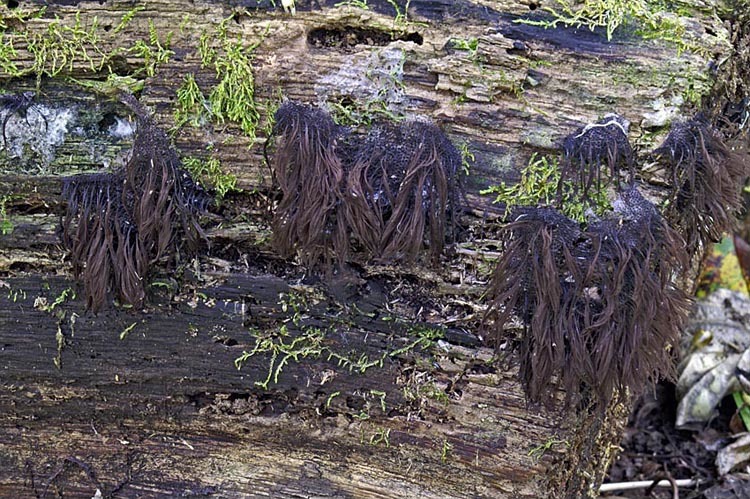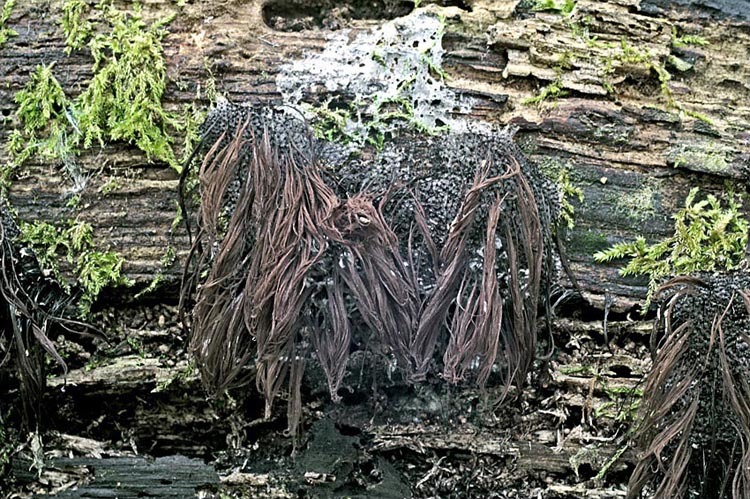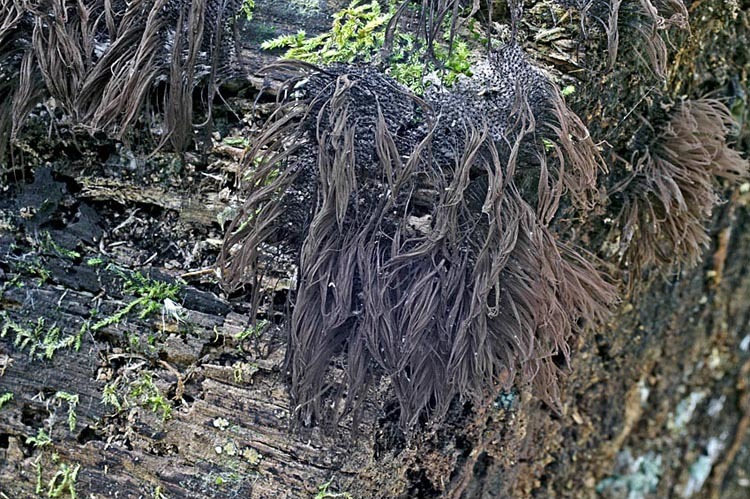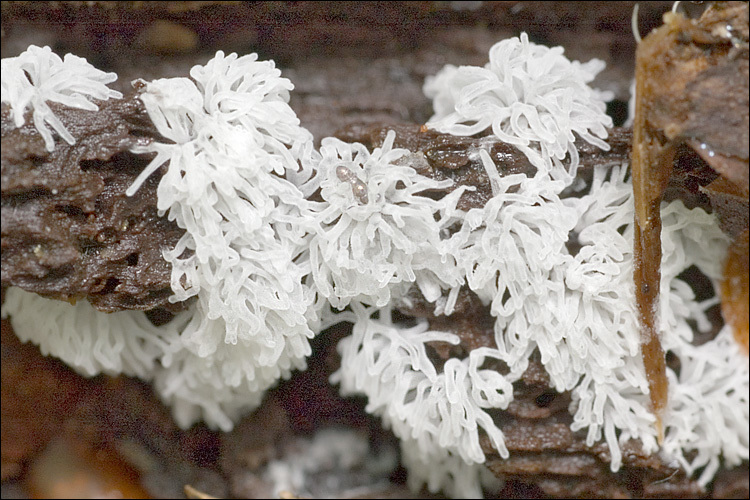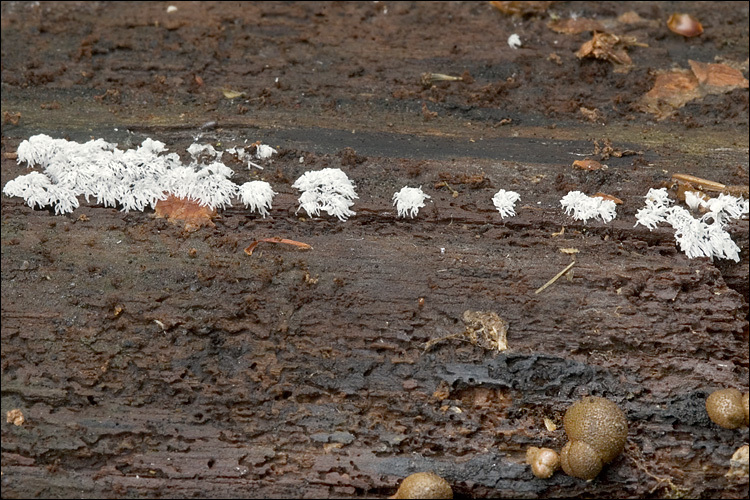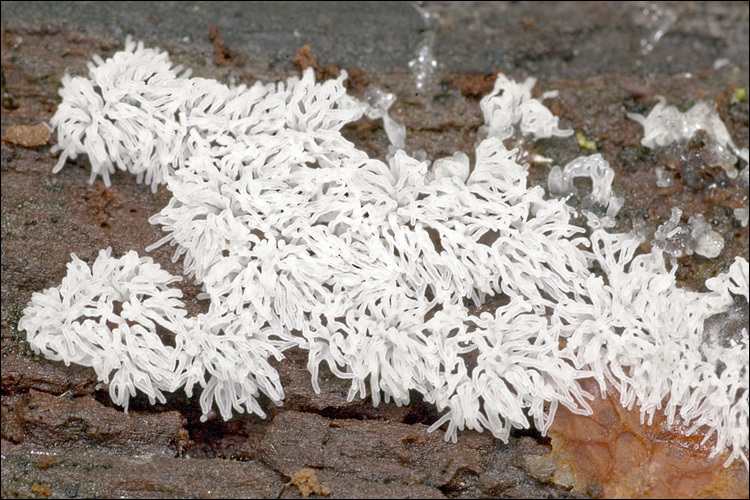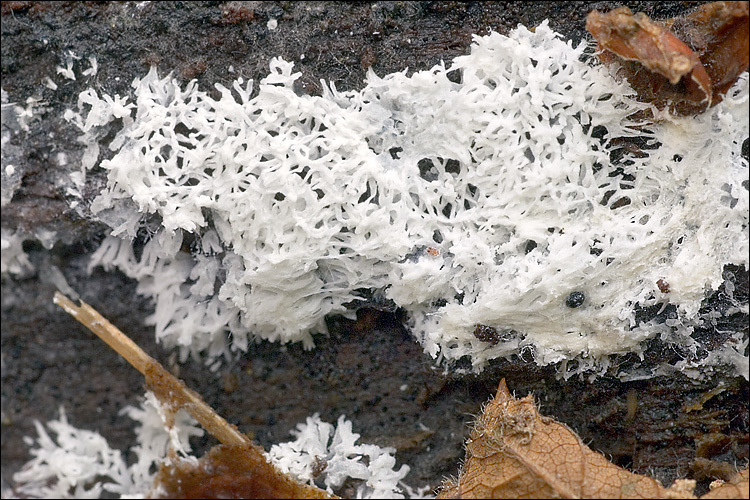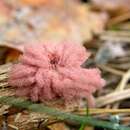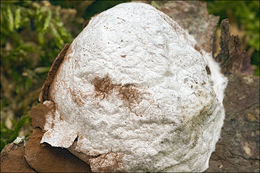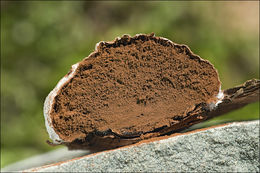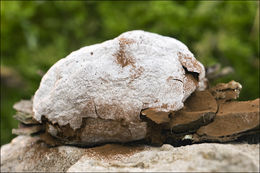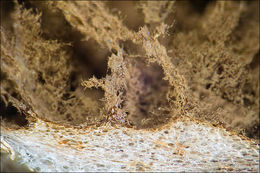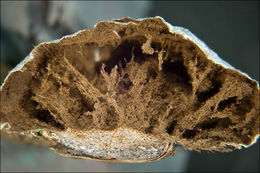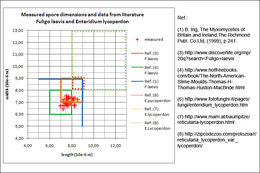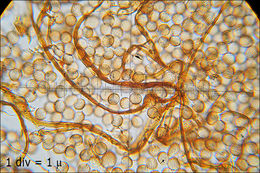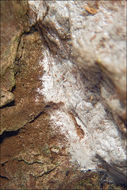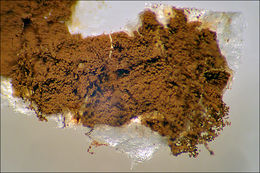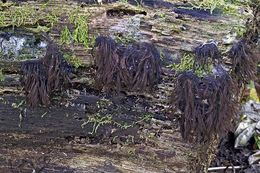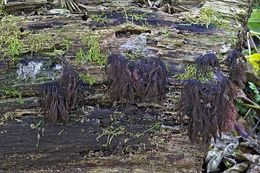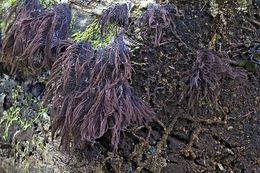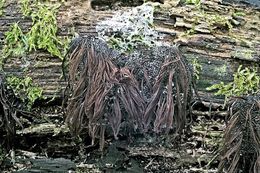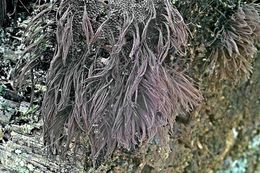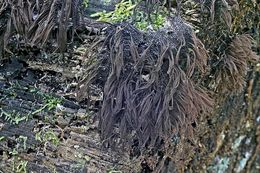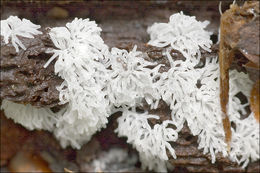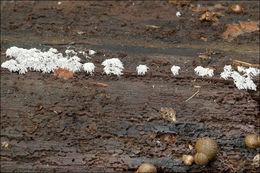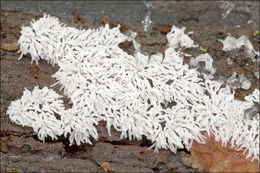-
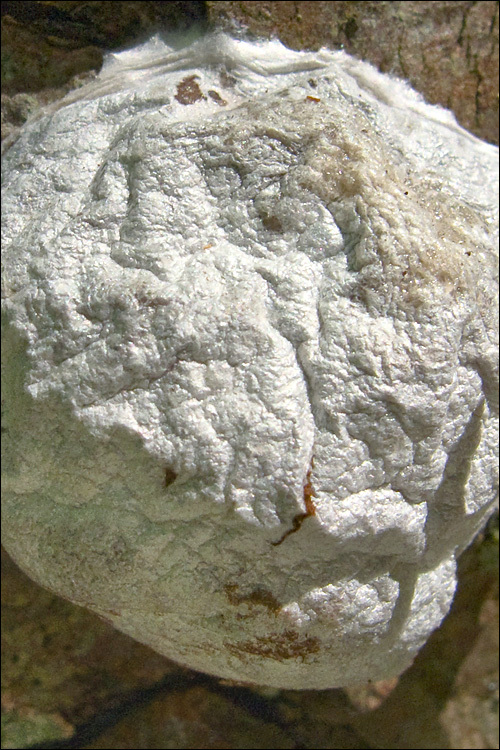
Slo.: ?? - Syn.: Fuligo septica var. leavis - Habitat: Mixed mountain forest, dominant Picea abies and Fagus sylvatica, south oriented slope, warm place, calcareous bedrock, mostly in shade, partly protected from direct rain by tree canopies, average precipitation ~ 3.000 mm/year, average temperature 4-6 deg C, elevation 1.200 m (4.400 feet), alpine phytogeographical region. - Substratum: Dry, still intact bark of a recently wind fallen Picea abies, about 60 cm (2 feet) above ground. - Comment: Info on F. laevis on internet is sparse and somewhat confusing. However, because of unevenly colored spores (see arrows on the picture of spores) and generally good fit to the key in Ref.:(1) I decided for F. laevis. Yet, this would need an expert opinion. Three aethalia present of diameter 2-3.5 cm (0.8-1.4 inch) and ~1.5 cm (0.6 inch) thickness. SP chocolate brown, oac637 (The Online Auction Color Chart); cortex whitish, oac900, thin, shiny, fragile. Hypothallus white, shiny, thin, inconspicuous. - Note: Unevenly colored spores with lighter areas (arrows). Comparison of measured spore dimensions and data from literature for Fuligo laevis and Enteridium lycoperdon (an alternative). - Spores globose to subglobose, verruculose, paler on one side; dimensions: 7.7 (SD = 0.4) x 7.1 (SD = 0.3) micr., Q = 1.09 (SD = 0.06), n = 30. Motic B2-211A, magnification 1.000 x, oil, in water. - Ref.: (1) B. Ing, The Myxomycetes of Britain and Ireland,The Richmond Publ. Co.Ltd, (1999), p 241. (8-90 za Enteridium lycoperdon) (2) S.L.Stephenson and H.Stempen, Myxomycetes, Timber Press Inc.(2000), p 123. (3) http://www.discoverlife.org/mp/20q?search=Fuligo+laevis 7-9 (4) http://www.hotfreebooks.com/book/The-North-American-Slime-Moulds-Thomas-H-Thomas-Huston-MacBride.html ------- for Enteridium lycoperdon: (5) http://champyves.pagesperso-orange.fr/champignons/fichier_htm/autres/Enteridium_lycoperdon. (6) http://www.fotofunghi.it/pages/fungi/enteridium_lycoperdon.htm (7) http://www.marn.at/baumpilze/reticularia-lycoperdon.html (8) http://zipcodezoo.com/protozoa/r/reticularia_lycoperdon_var._lycoperdon/ - Key to the Order: Ref.:(1) B. Ing, The Myxomycetes of Britain and Ireland,The Richmond Publ. Co.Ltd, (1999), p 10.
-
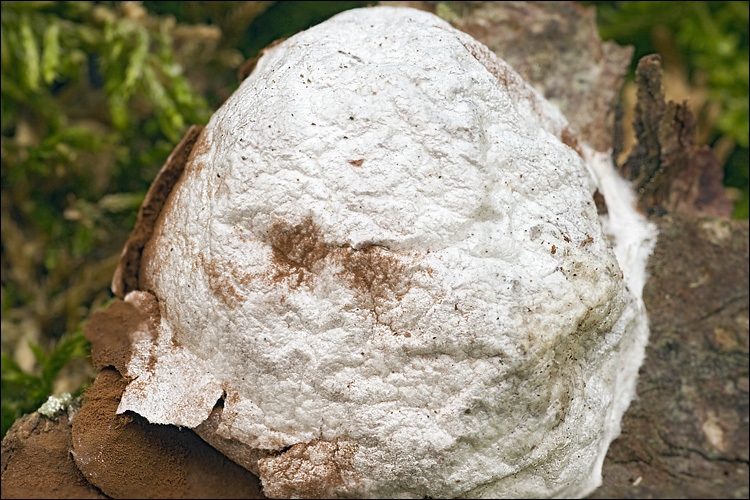
Slo.: ?? - Syn.: Fuligo septica var. leavis - Habitat: Mixed mountain forest, dominant Picea abies and Fagus sylvatica, south oriented slope, warm place, calcareous bedrock, mostly in shade, partly protected from direct rain by tree canopies, average precipitation ~ 3.000 mm/year, average temperature 4-6 deg C, elevation 1.200 m (4.400 feet), alpine phytogeographical region. - Substratum: Dry, still intact bark of a recently wind fallen Picea abies, about 60 cm (2 feet) above ground. - Comment: Info on F. laevis on internet is sparse and somewhat confusing. However, because of unevenly colored spores (see arrows on the picture of spores) and generally good fit to the key in Ref.:(1) I decided for F. laevis. Yet, this would need an expert opinion. Three aethalia present of diameter 2-3.5 cm (0.8-1.4 inch) and ~1.5 cm (0.6 inch) thickness. SP chocolate brown, oac637 (The Online Auction Color Chart); cortex whitish, oac900, thin, shiny, fragile. Hypothallus white, shiny, thin, inconspicuous. - Note: Unevenly colored spores with lighter areas (arrows). Comparison of measured spore dimensions and data from literature for Fuligo laevis and Enteridium lycoperdon (an alternative). - Spores globose to subglobose, verruculose, paler on one side; dimensions: 7.7 (SD = 0.4) x 7.1 (SD = 0.3) micr., Q = 1.09 (SD = 0.06), n = 30. Motic B2-211A, magnification 1.000 x, oil, in water. - Ref.: (1) B. Ing, The Myxomycetes of Britain and Ireland,The Richmond Publ. Co.Ltd, (1999), p 241. (8-90 za Enteridium lycoperdon) (2) S.L.Stephenson and H.Stempen, Myxomycetes, Timber Press Inc.(2000), p 123. (3) http://www.discoverlife.org/mp/20q?search=Fuligo+laevis 7-9 (4) http://www.hotfreebooks.com/book/The-North-American-Slime-Moulds-Thomas-H-Thomas-Huston-MacBride.html ------- for Enteridium lycoperdon: (5) http://champyves.pagesperso-orange.fr/champignons/fichier_htm/autres/Enteridium_lycoperdon. (6) http://www.fotofunghi.it/pages/fungi/enteridium_lycoperdon.htm (7) http://www.marn.at/baumpilze/reticularia-lycoperdon.html (8) http://zipcodezoo.com/protozoa/r/reticularia_lycoperdon_var._lycoperdon/ - Key to the Order: Ref.:(1) B. Ing, The Myxomycetes of Britain and Ireland,The Richmond Publ. Co.Ltd, (1999), p 10.
-
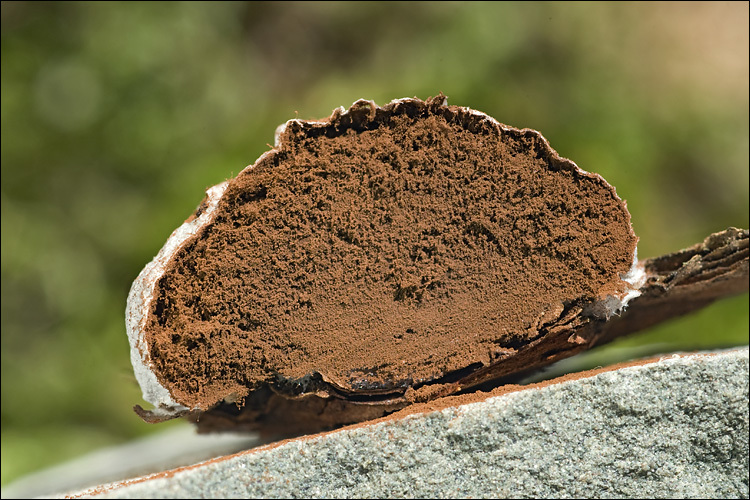
Slo.: ?? - Syn.: Fuligo septica var. leavis - Habitat: Mixed mountain forest, dominant Picea abies and Fagus sylvatica, south oriented slope, warm place, calcareous bedrock, mostly in shade, partly protected from direct rain by tree canopies, average precipitation ~ 3.000 mm/year, average temperature 4-6 deg C, elevation 1.200 m (4.400 feet), alpine phytogeographical region. - Substratum: Dry, still intact bark of a recently wind fallen Picea abies, about 60 cm (2 feet) above ground. - Comment: Info on F. laevis on internet is sparse and somewhat confusing. However, because of unevenly colored spores (see arrows on the picture of spores) and generally good fit to the key in Ref.:(1) I decided for F. laevis. Yet, this would need an expert opinion. Three aethalia present of diameter 2-3.5 cm (0.8-1.4 inch) and ~1.5 cm (0.6 inch) thickness. SP chocolate brown, oac637 (The Online Auction Color Chart); cortex whitish, oac900, thin, shiny, fragile. Hypothallus white, shiny, thin, inconspicuous. - Note: Unevenly colored spores with lighter areas (arrows). Comparison of measured spore dimensions and data from literature for Fuligo laevis and Enteridium lycoperdon (an alternative). - Spores globose to subglobose, verruculose, paler on one side; dimensions: 7.7 (SD = 0.4) x 7.1 (SD = 0.3) micr., Q = 1.09 (SD = 0.06), n = 30. Motic B2-211A, magnification 1.000 x, oil, in water. - Ref.: (1) B. Ing, The Myxomycetes of Britain and Ireland,The Richmond Publ. Co.Ltd, (1999), p 241. (8-90 za Enteridium lycoperdon) (2) S.L.Stephenson and H.Stempen, Myxomycetes, Timber Press Inc.(2000), p 123. (3) http://www.discoverlife.org/mp/20q?search=Fuligo+laevis 7-9 (4) http://www.hotfreebooks.com/book/The-North-American-Slime-Moulds-Thomas-H-Thomas-Huston-MacBride.html ------- for Enteridium lycoperdon: (5) http://champyves.pagesperso-orange.fr/champignons/fichier_htm/autres/Enteridium_lycoperdon. (6) http://www.fotofunghi.it/pages/fungi/enteridium_lycoperdon.htm (7) http://www.marn.at/baumpilze/reticularia-lycoperdon.html (8) http://zipcodezoo.com/protozoa/r/reticularia_lycoperdon_var._lycoperdon/ - Key to the Order: Ref.:(1) B. Ing, The Myxomycetes of Britain and Ireland,The Richmond Publ. Co.Ltd, (1999), p 10.
-
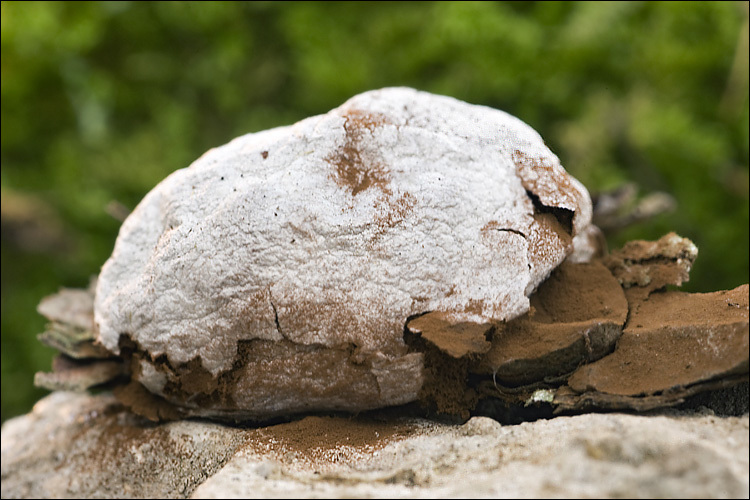
Slo.: ?? - Syn.: Fuligo septica var. leavis - Habitat: Mixed mountain forest, dominant Picea abies and Fagus sylvatica, south oriented slope, warm place, calcareous bedrock, mostly in shade, partly protected from direct rain by tree canopies, average precipitation ~ 3.000 mm/year, average temperature 4-6 deg C, elevation 1.200 m (4.400 feet), alpine phytogeographical region. - Substratum: Dry, still intact bark of a recently wind fallen Picea abies, about 60 cm (2 feet) above ground. - Comment: Info on F. laevis on internet is sparse and somewhat confusing. However, because of unevenly colored spores (see arrows on the picture of spores) and generally good fit to the key in Ref.:(1) I decided for F. laevis. Yet, this would need an expert opinion. Three aethalia present of diameter 2-3.5 cm (0.8-1.4 inch) and ~1.5 cm (0.6 inch) thickness. SP chocolate brown, oac637 (The Online Auction Color Chart); cortex whitish, oac900, thin, shiny, fragile. Hypothallus white, shiny, thin, inconspicuous. - Note: Unevenly colored spores with lighter areas (arrows). Comparison of measured spore dimensions and data from literature for Fuligo laevis and Enteridium lycoperdon (an alternative). - Spores globose to subglobose, verruculose, paler on one side; dimensions: 7.7 (SD = 0.4) x 7.1 (SD = 0.3) micr., Q = 1.09 (SD = 0.06), n = 30. Motic B2-211A, magnification 1.000 x, oil, in water. - Ref.: (1) B. Ing, The Myxomycetes of Britain and Ireland,The Richmond Publ. Co.Ltd, (1999), p 241. (8-90 za Enteridium lycoperdon) (2) S.L.Stephenson and H.Stempen, Myxomycetes, Timber Press Inc.(2000), p 123. (3) http://www.discoverlife.org/mp/20q?search=Fuligo+laevis 7-9 (4) http://www.hotfreebooks.com/book/The-North-American-Slime-Moulds-Thomas-H-Thomas-Huston-MacBride.html ------- for Enteridium lycoperdon: (5) http://champyves.pagesperso-orange.fr/champignons/fichier_htm/autres/Enteridium_lycoperdon. (6) http://www.fotofunghi.it/pages/fungi/enteridium_lycoperdon.htm (7) http://www.marn.at/baumpilze/reticularia-lycoperdon.html (8) http://zipcodezoo.com/protozoa/r/reticularia_lycoperdon_var._lycoperdon/ - Key to the Order: Ref.:(1) B. Ing, The Myxomycetes of Britain and Ireland,The Richmond Publ. Co.Ltd, (1999), p 10.
-
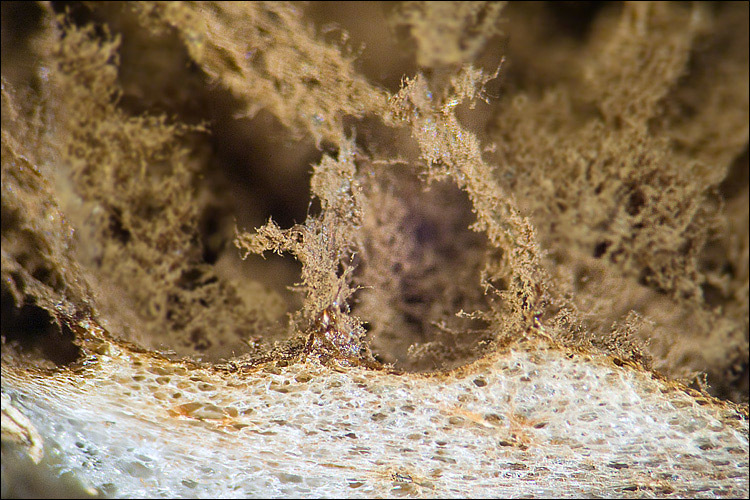
Slo.: ?? - Syn.: Fuligo septica var. leavis - Habitat: Mixed mountain forest, dominant Picea abies and Fagus sylvatica, south oriented slope, warm place, calcareous bedrock, mostly in shade, partly protected from direct rain by tree canopies, average precipitation ~ 3.000 mm/year, average temperature 4-6 deg C, elevation 1.200 m (4.400 feet), alpine phytogeographical region. - Substratum: Dry, still intact bark of a recently wind fallen Picea abies, about 60 cm (2 feet) above ground. - Comment: Info on F. laevis on internet is sparse and somewhat confusing. However, because of unevenly colored spores (see arrows on the picture of spores) and generally good fit to the key in Ref.:(1) I decided for F. laevis. Yet, this would need an expert opinion. Three aethalia present of diameter 2-3.5 cm (0.8-1.4 inch) and ~1.5 cm (0.6 inch) thickness. SP chocolate brown, oac637 (The Online Auction Color Chart); cortex whitish, oac900, thin, shiny, fragile. Hypothallus white, shiny, thin, inconspicuous. - Note: Unevenly colored spores with lighter areas (arrows). Comparison of measured spore dimensions and data from literature for Fuligo laevis and Enteridium lycoperdon (an alternative). - Spores globose to subglobose, verruculose, paler on one side; dimensions: 7.7 (SD = 0.4) x 7.1 (SD = 0.3) micr., Q = 1.09 (SD = 0.06), n = 30. Motic B2-211A, magnification 1.000 x, oil, in water. - Ref.: (1) B. Ing, The Myxomycetes of Britain and Ireland,The Richmond Publ. Co.Ltd, (1999), p 241. (8-90 za Enteridium lycoperdon) (2) S.L.Stephenson and H.Stempen, Myxomycetes, Timber Press Inc.(2000), p 123. (3) http://www.discoverlife.org/mp/20q?search=Fuligo+laevis 7-9 (4) http://www.hotfreebooks.com/book/The-North-American-Slime-Moulds-Thomas-H-Thomas-Huston-MacBride.html ------- for Enteridium lycoperdon: (5) http://champyves.pagesperso-orange.fr/champignons/fichier_htm/autres/Enteridium_lycoperdon. (6) http://www.fotofunghi.it/pages/fungi/enteridium_lycoperdon.htm (7) http://www.marn.at/baumpilze/reticularia-lycoperdon.html (8) http://zipcodezoo.com/protozoa/r/reticularia_lycoperdon_var._lycoperdon/ - Key to the Order: Ref.:(1) B. Ing, The Myxomycetes of Britain and Ireland,The Richmond Publ. Co.Ltd, (1999), p 10.
-
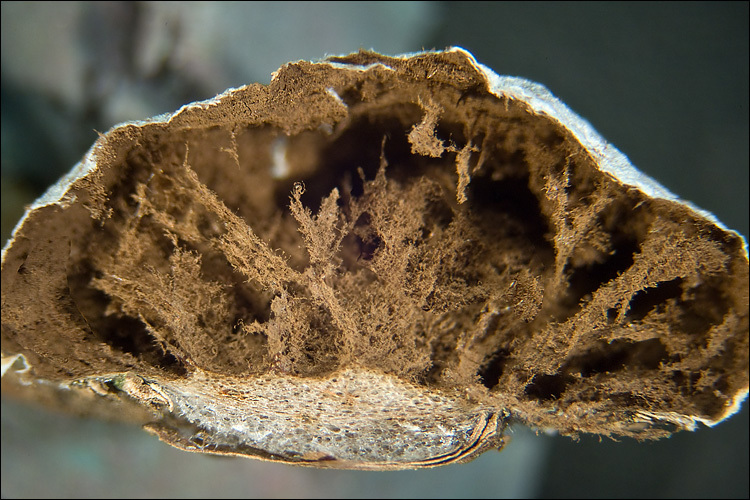
Slo.: ?? - Syn.: Fuligo septica var. leavis - Habitat: Mixed mountain forest, dominant Picea abies and Fagus sylvatica, south oriented slope, warm place, calcareous bedrock, mostly in shade, partly protected from direct rain by tree canopies, average precipitation ~ 3.000 mm/year, average temperature 4-6 deg C, elevation 1.200 m (4.400 feet), alpine phytogeographical region. - Substratum: Dry, still intact bark of a recently wind fallen Picea abies, about 60 cm (2 feet) above ground. - Comment: Info on F. laevis on internet is sparse and somewhat confusing. However, because of unevenly colored spores (see arrows on the picture of spores) and generally good fit to the key in Ref.:(1) I decided for F. laevis. Yet, this would need an expert opinion. Three aethalia present of diameter 2-3.5 cm (0.8-1.4 inch) and ~1.5 cm (0.6 inch) thickness. SP chocolate brown, oac637 (The Online Auction Color Chart); cortex whitish, oac900, thin, shiny, fragile. Hypothallus white, shiny, thin, inconspicuous. - Note: Unevenly colored spores with lighter areas (arrows). Comparison of measured spore dimensions and data from literature for Fuligo laevis and Enteridium lycoperdon (an alternative). - Spores globose to subglobose, verruculose, paler on one side; dimensions: 7.7 (SD = 0.4) x 7.1 (SD = 0.3) micr., Q = 1.09 (SD = 0.06), n = 30. Motic B2-211A, magnification 1.000 x, oil, in water. - Ref.: (1) B. Ing, The Myxomycetes of Britain and Ireland,The Richmond Publ. Co.Ltd, (1999), p 241. (8-90 za Enteridium lycoperdon) (2) S.L.Stephenson and H.Stempen, Myxomycetes, Timber Press Inc.(2000), p 123. (3) http://www.discoverlife.org/mp/20q?search=Fuligo+laevis 7-9 (4) http://www.hotfreebooks.com/book/The-North-American-Slime-Moulds-Thomas-H-Thomas-Huston-MacBride.html ------- for Enteridium lycoperdon: (5) http://champyves.pagesperso-orange.fr/champignons/fichier_htm/autres/Enteridium_lycoperdon. (6) http://www.fotofunghi.it/pages/fungi/enteridium_lycoperdon.htm (7) http://www.marn.at/baumpilze/reticularia-lycoperdon.html (8) http://zipcodezoo.com/protozoa/r/reticularia_lycoperdon_var._lycoperdon/ - Key to the Order: Ref.:(1) B. Ing, The Myxomycetes of Britain and Ireland,The Richmond Publ. Co.Ltd, (1999), p 10.
-

Slo.: ?? - Syn.: Fuligo septica var. leavis - Habitat: Mixed mountain forest, dominant Picea abies and Fagus sylvatica, south oriented slope, warm place, calcareous bedrock, mostly in shade, partly protected from direct rain by tree canopies, average precipitation ~ 3.000 mm/year, average temperature 4-6 deg C, elevation 1.200 m (4.400 feet), alpine phytogeographical region. - Substratum: Dry, still intact bark of a recently wind fallen Picea abies, about 60 cm (2 feet) above ground. - Comment: Info on F. laevis on internet is sparse and somewhat confusing. However, because of unevenly colored spores (see arrows on the picture of spores) and generally good fit to the key in Ref.:(1) I decided for F. laevis. Yet, this would need an expert opinion. Three aethalia present of diameter 2-3.5 cm (0.8-1.4 inch) and ~1.5 cm (0.6 inch) thickness. SP chocolate brown, oac637 (The Online Auction Color Chart); cortex whitish, oac900, thin, shiny, fragile. Hypothallus white, shiny, thin, inconspicuous. - Note: Unevenly colored spores with lighter areas (arrows). Comparison of measured spore dimensions and data from literature for Fuligo laevis and Enteridium lycoperdon (an alternative). - Spores globose to subglobose, verruculose, paler on one side; dimensions: 7.7 (SD = 0.4) x 7.1 (SD = 0.3) micr., Q = 1.09 (SD = 0.06), n = 30. Motic B2-211A, magnification 1.000 x, oil, in water. - Ref.: (1) B. Ing, The Myxomycetes of Britain and Ireland,The Richmond Publ. Co.Ltd, (1999), p 241. (8-90 za Enteridium lycoperdon) (2) S.L.Stephenson and H.Stempen, Myxomycetes, Timber Press Inc.(2000), p 123. (3) http://www.discoverlife.org/mp/20q?search=Fuligo+laevis 7-9 (4) http://www.hotfreebooks.com/book/The-North-American-Slime-Moulds-Thomas-H-Thomas-Huston-MacBride.html ------- for Enteridium lycoperdon: (5) http://champyves.pagesperso-orange.fr/champignons/fichier_htm/autres/Enteridium_lycoperdon. (6) http://www.fotofunghi.it/pages/fungi/enteridium_lycoperdon.htm (7) http://www.marn.at/baumpilze/reticularia-lycoperdon.html (8) http://zipcodezoo.com/protozoa/r/reticularia_lycoperdon_var._lycoperdon/ - Key to the Order: Ref.:(1) B. Ing, The Myxomycetes of Britain and Ireland,The Richmond Publ. Co.Ltd, (1999), p 10.
-
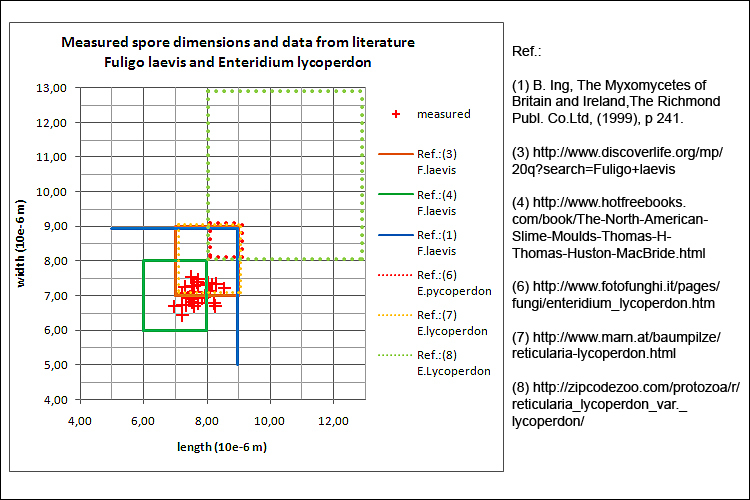
Slo.: ?? - Syn.: Fuligo septica var. leavis - Habitat: Mixed mountain forest, dominant Picea abies and Fagus sylvatica, south oriented slope, warm place, calcareous bedrock, mostly in shade, partly protected from direct rain by tree canopies, average precipitation ~ 3.000 mm/year, average temperature 4-6 deg C, elevation 1.200 m (4.400 feet), alpine phytogeographical region. - Substratum: Dry, still intact bark of a recently wind fallen Picea abies, about 60 cm (2 feet) above ground. - Comment: Info on F. laevis on internet is sparse and somewhat confusing. However, because of unevenly colored spores (see arrows on the picture of spores) and generally good fit to the key in Ref.:(1) I decided for F. laevis. Yet, this would need an expert opinion. Three aethalia present of diameter 2-3.5 cm (0.8-1.4 inch) and ~1.5 cm (0.6 inch) thickness. SP chocolate brown, oac637 (The Online Auction Color Chart); cortex whitish, oac900, thin, shiny, fragile. Hypothallus white, shiny, thin, inconspicuous. - Note: Unevenly colored spores with lighter areas (arrows). Comparison of measured spore dimensions and data from literature for Fuligo laevis and Enteridium lycoperdon (an alternative). - Spores globose to subglobose, verruculose, paler on one side; dimensions: 7.7 (SD = 0.4) x 7.1 (SD = 0.3) micr., Q = 1.09 (SD = 0.06), n = 30. Motic B2-211A, magnification 1.000 x, oil, in water. - Ref.: (1) B. Ing, The Myxomycetes of Britain and Ireland,The Richmond Publ. Co.Ltd, (1999), p 241. (8-90 za Enteridium lycoperdon) (2) S.L.Stephenson and H.Stempen, Myxomycetes, Timber Press Inc.(2000), p 123. (3) http://www.discoverlife.org/mp/20q?search=Fuligo+laevis 7-9 (4) http://www.hotfreebooks.com/book/The-North-American-Slime-Moulds-Thomas-H-Thomas-Huston-MacBride.html ------- for Enteridium lycoperdon: (5) http://champyves.pagesperso-orange.fr/champignons/fichier_htm/autres/Enteridium_lycoperdon. (6) http://www.fotofunghi.it/pages/fungi/enteridium_lycoperdon.htm (7) http://www.marn.at/baumpilze/reticularia-lycoperdon.html (8) http://zipcodezoo.com/protozoa/r/reticularia_lycoperdon_var._lycoperdon/ - Key to the Order: Ref.:(1) B. Ing, The Myxomycetes of Britain and Ireland,The Richmond Publ. Co.Ltd, (1999), p 10.
-
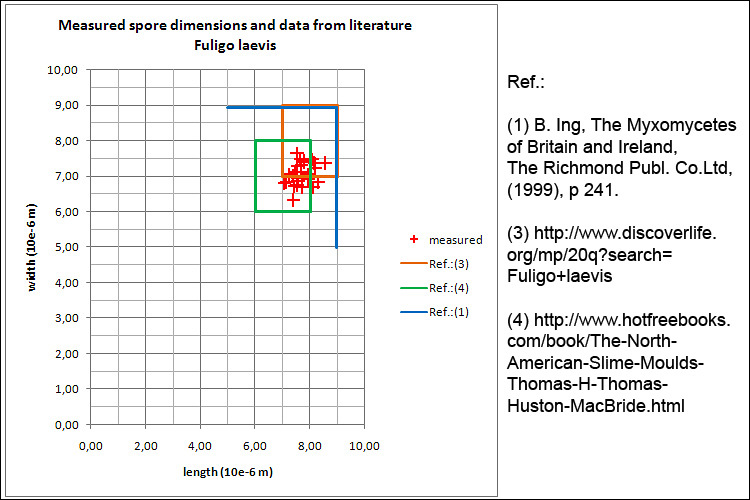
Slo.: ?? - Syn.: Fuligo septica var. leavis - Habitat: Mixed mountain forest, dominant Picea abies and Fagus sylvatica, south oriented slope, warm place, calcareous bedrock, mostly in shade, partly protected from direct rain by tree canopies, average precipitation ~ 3.000 mm/year, average temperature 4-6 deg C, elevation 1.200 m (4.400 feet), alpine phytogeographical region. - Substratum: Dry, still intact bark of a recently wind fallen Picea abies, about 60 cm (2 feet) above ground. - Comment: Info on F. laevis on internet is sparse and somewhat confusing. However, because of unevenly colored spores (see arrows on the picture of spores) and generally good fit to the key in Ref.:(1) I decided for F. laevis. Yet, this would need an expert opinion. Three aethalia present of diameter 2-3.5 cm (0.8-1.4 inch) and ~1.5 cm (0.6 inch) thickness. SP chocolate brown, oac637 (The Online Auction Color Chart); cortex whitish, oac900, thin, shiny, fragile. Hypothallus white, shiny, thin, inconspicuous. - Note: Unevenly colored spores with lighter areas (arrows). Comparison of measured spore dimensions and data from literature for Fuligo laevis and Enteridium lycoperdon (an alternative). - Spores globose to subglobose, verruculose, paler on one side; dimensions: 7.7 (SD = 0.4) x 7.1 (SD = 0.3) micr., Q = 1.09 (SD = 0.06), n = 30. Motic B2-211A, magnification 1.000 x, oil, in water. - Ref.: (1) B. Ing, The Myxomycetes of Britain and Ireland,The Richmond Publ. Co.Ltd, (1999), p 241. (8-90 za Enteridium lycoperdon) (2) S.L.Stephenson and H.Stempen, Myxomycetes, Timber Press Inc.(2000), p 123. (3) http://www.discoverlife.org/mp/20q?search=Fuligo+laevis 7-9 (4) http://www.hotfreebooks.com/book/The-North-American-Slime-Moulds-Thomas-H-Thomas-Huston-MacBride.html ------- for Enteridium lycoperdon: (5) http://champyves.pagesperso-orange.fr/champignons/fichier_htm/autres/Enteridium_lycoperdon. (6) http://www.fotofunghi.it/pages/fungi/enteridium_lycoperdon.htm (7) http://www.marn.at/baumpilze/reticularia-lycoperdon.html (8) http://zipcodezoo.com/protozoa/r/reticularia_lycoperdon_var._lycoperdon/ - Key to the Order: Ref.:(1) B. Ing, The Myxomycetes of Britain and Ireland,The Richmond Publ. Co.Ltd, (1999), p 10.
-
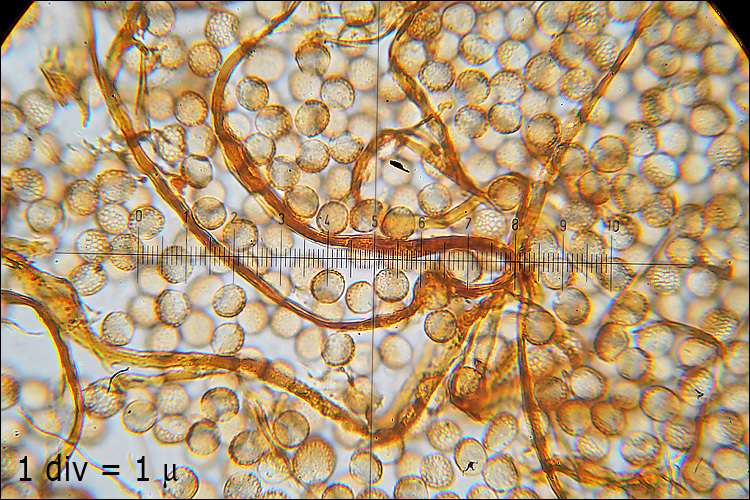
Slo.: ?? - Syn.: Fuligo septica var. leavis - Habitat: Mixed mountain forest, dominant Picea abies and Fagus sylvatica, south oriented slope, warm place, calcareous bedrock, mostly in shade, partly protected from direct rain by tree canopies, average precipitation ~ 3.000 mm/year, average temperature 4-6 deg C, elevation 1.200 m (4.400 feet), alpine phytogeographical region. - Substratum: Dry, still intact bark of a recently wind fallen Picea abies, about 60 cm (2 feet) above ground. - Comment: Info on F. laevis on internet is sparse and somewhat confusing. However, because of unevenly colored spores (see arrows on the picture of spores) and generally good fit to the key in Ref.:(1) I decided for F. laevis. Yet, this would need an expert opinion. Three aethalia present of diameter 2-3.5 cm (0.8-1.4 inch) and ~1.5 cm (0.6 inch) thickness. SP chocolate brown, oac637 (The Online Auction Color Chart); cortex whitish, oac900, thin, shiny, fragile. Hypothallus white, shiny, thin, inconspicuous. - Note: Unevenly colored spores with lighter areas (arrows). Comparison of measured spore dimensions and data from literature for Fuligo laevis and Enteridium lycoperdon (an alternative). - Spores globose to subglobose, verruculose, paler on one side; dimensions: 7.7 (SD = 0.4) x 7.1 (SD = 0.3) micr., Q = 1.09 (SD = 0.06), n = 30. Motic B2-211A, magnification 1.000 x, oil, in water. - Ref.: (1) B. Ing, The Myxomycetes of Britain and Ireland,The Richmond Publ. Co.Ltd, (1999), p 241. (8-90 za Enteridium lycoperdon) (2) S.L.Stephenson and H.Stempen, Myxomycetes, Timber Press Inc.(2000), p 123. (3) http://www.discoverlife.org/mp/20q?search=Fuligo+laevis 7-9 (4) http://www.hotfreebooks.com/book/The-North-American-Slime-Moulds-Thomas-H-Thomas-Huston-MacBride.html ------- for Enteridium lycoperdon: (5) http://champyves.pagesperso-orange.fr/champignons/fichier_htm/autres/Enteridium_lycoperdon. (6) http://www.fotofunghi.it/pages/fungi/enteridium_lycoperdon.htm (7) http://www.marn.at/baumpilze/reticularia-lycoperdon.html (8) http://zipcodezoo.com/protozoa/r/reticularia_lycoperdon_var._lycoperdon/ - Key to the Order: Ref.:(1) B. Ing, The Myxomycetes of Britain and Ireland,The Richmond Publ. Co.Ltd, (1999), p 10.
-
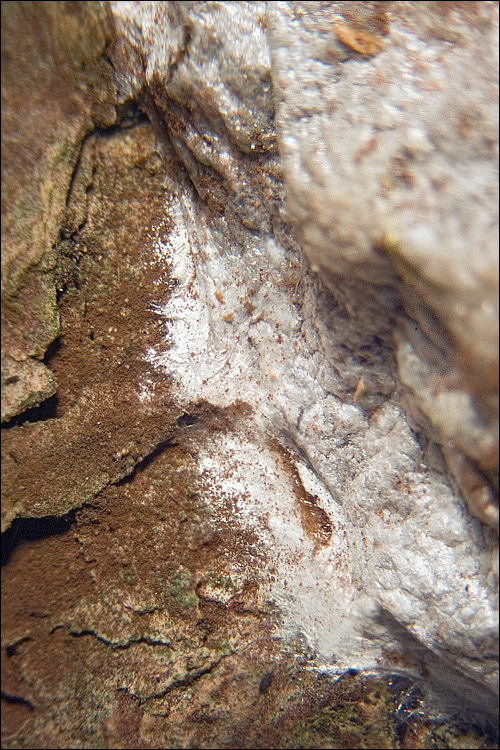
Slo.: ?? - Syn.: Fuligo septica var. leavis - Habitat: Mixed mountain forest, dominant Picea abies and Fagus sylvatica, south oriented slope, warm place, calcareous bedrock, mostly in shade, partly protected from direct rain by tree canopies, average precipitation ~ 3.000 mm/year, average temperature 4-6 deg C, elevation 1.200 m (4.400 feet), alpine phytogeographical region. - Substratum: Dry, still intact bark of a recently wind fallen Picea abies, about 60 cm (2 feet) above ground. - Comment: Info on F. laevis on internet is sparse and somewhat confusing. However, because of unevenly colored spores (see arrows on the picture of spores) and generally good fit to the key in Ref.:(1) I decided for F. laevis. Yet, this would need an expert opinion. Three aethalia present of diameter 2-3.5 cm (0.8-1.4 inch) and ~1.5 cm (0.6 inch) thickness. SP chocolate brown, oac637 (The Online Auction Color Chart); cortex whitish, oac900, thin, shiny, fragile. Hypothallus white, shiny, thin, inconspicuous. - Note: Unevenly colored spores with lighter areas (arrows). Comparison of measured spore dimensions and data from literature for Fuligo laevis and Enteridium lycoperdon (an alternative). - Spores globose to subglobose, verruculose, paler on one side; dimensions: 7.7 (SD = 0.4) x 7.1 (SD = 0.3) micr., Q = 1.09 (SD = 0.06), n = 30. Motic B2-211A, magnification 1.000 x, oil, in water. - Ref.: (1) B. Ing, The Myxomycetes of Britain and Ireland,The Richmond Publ. Co.Ltd, (1999), p 241. (8-90 za Enteridium lycoperdon) (2) S.L.Stephenson and H.Stempen, Myxomycetes, Timber Press Inc.(2000), p 123. (3) http://www.discoverlife.org/mp/20q?search=Fuligo+laevis 7-9 (4) http://www.hotfreebooks.com/book/The-North-American-Slime-Moulds-Thomas-H-Thomas-Huston-MacBride.html ------- for Enteridium lycoperdon: (5) http://champyves.pagesperso-orange.fr/champignons/fichier_htm/autres/Enteridium_lycoperdon. (6) http://www.fotofunghi.it/pages/fungi/enteridium_lycoperdon.htm (7) http://www.marn.at/baumpilze/reticularia-lycoperdon.html (8) http://zipcodezoo.com/protozoa/r/reticularia_lycoperdon_var._lycoperdon/ - Key to the Order: Ref.:(1) B. Ing, The Myxomycetes of Britain and Ireland,The Richmond Publ. Co.Ltd, (1999), p 10.
-

Slo.: ?? - Syn.: Fuligo septica var. leavis - Habitat: Mixed mountain forest, dominant Picea abies and Fagus sylvatica, south oriented slope, warm place, calcareous bedrock, mostly in shade, partly protected from direct rain by tree canopies, average precipitation ~ 3.000 mm/year, average temperature 4-6 deg C, elevation 1.200 m (4.400 feet), alpine phytogeographical region. - Substratum: Dry, still intact bark of a recently wind fallen Picea abies, about 60 cm (2 feet) above ground. - Comment: Info on F. laevis on internet is sparse and somewhat confusing. However, because of unevenly colored spores (see arrows on the picture of spores) and generally good fit to the key in Ref.:(1) I decided for F. laevis. Yet, this would need an expert opinion. Three aethalia present of diameter 2-3.5 cm (0.8-1.4 inch) and ~1.5 cm (0.6 inch) thickness. SP chocolate brown, oac637 (The Online Auction Color Chart); cortex whitish, oac900, thin, shiny, fragile. Hypothallus white, shiny, thin, inconspicuous. - Note: Unevenly colored spores with lighter areas (arrows). Comparison of measured spore dimensions and data from literature for Fuligo laevis and Enteridium lycoperdon (an alternative). - Spores globose to subglobose, verruculose, paler on one side; dimensions: 7.7 (SD = 0.4) x 7.1 (SD = 0.3) micr., Q = 1.09 (SD = 0.06), n = 30. Motic B2-211A, magnification 1.000 x, oil, in water. - Ref.: (1) B. Ing, The Myxomycetes of Britain and Ireland,The Richmond Publ. Co.Ltd, (1999), p 241. (8-90 za Enteridium lycoperdon) (2) S.L.Stephenson and H.Stempen, Myxomycetes, Timber Press Inc.(2000), p 123. (3) http://www.discoverlife.org/mp/20q?search=Fuligo+laevis 7-9 (4) http://www.hotfreebooks.com/book/The-North-American-Slime-Moulds-Thomas-H-Thomas-Huston-MacBride.html ------- for Enteridium lycoperdon: (5) http://champyves.pagesperso-orange.fr/champignons/fichier_htm/autres/Enteridium_lycoperdon. (6) http://www.fotofunghi.it/pages/fungi/enteridium_lycoperdon.htm (7) http://www.marn.at/baumpilze/reticularia-lycoperdon.html (8) http://zipcodezoo.com/protozoa/r/reticularia_lycoperdon_var._lycoperdon/ - Key to the Order: Ref.:(1) B. Ing, The Myxomycetes of Britain and Ireland,The Richmond Publ. Co.Ltd, (1999), p 10.
-
-
-
-
-
-
-
-
Habitat: mixed wood in a ravine, cretaceous clastic rock (flysh), rain protected by trees canopies and tall herb, in shade, very humid, precipitations ~3.000 mm/year, average temperature 8-10 deg C, altitude 450 m (1.500 feet), alpine phytogeographical region. Substratum: fallen, debarked and completely rotten deciduous tree trunk. Comment: Determination uncertain and not verified by microscopic investigation. - Ref.: http://slimemold.uark.edu/fungi/WebForms/ImageSearchForm.aspx?letter=C
-
Habitat: mixed wood in a ravine, cretaceous clastic rock (flysh), rain protected by trees canopies and tall herb, in shade, very humid, precipitations ~3.000 mm/year, average temperature 8-10 deg C, altitude 450 m (1.500 feet), alpine phytogeographical region. Substratum: fallen, debarked and completely rotten deciduous tree trunk. Comment: Determination uncertain and not verified by microscopic investigation. - Ref.: http://slimemold.uark.edu/fungi/WebForms/ImageSearchForm.aspx?letter=C
-
Habitat: mixed wood in a ravine, cretaceous clastic rock (flysh), rain protected by trees canopies and tall herb, in shade, very humid, precipitations ~3.000 mm/year, average temperature 8-10 deg C, altitude 450 m (1.500 feet), alpine phytogeographical region. Substratum: fallen, debarked and completely rotten deciduous tree trunk. Comment: Determination uncertain and not verified by microscopic investigation. - Ref.: http://slimemold.uark.edu/fungi/WebForms/ImageSearchForm.aspx?letter=C
-
Habitat: mixed wood in a ravine, cretaceous clastic rock (flysh), rain protected by trees canopies and tall herb, in shade, very humid, precipitations ~3.000 mm/year, average temperature 8-10 deg C, altitude 450 m (1.500 feet), alpine phytogeographical region. Substratum: fallen, debarked and completely rotten deciduous tree trunk. Comment: Determination uncertain and not verified by microscopic investigation. - Ref.: http://slimemold.uark.edu/fungi/WebForms/ImageSearchForm.aspx?letter=C
-
Habitat: mixed wood in a ravine, cretaceous clastic rock (flysh), rain protected by trees canopies and tall herb, in shade, very humid, precipitations ~3.000 mm/year, average temperature 8-10 deg C, altitude 450 m (1.500 feet), alpine phytogeographical region. Substratum: fallen, debarked and completely rotten deciduous tree trunk. Comment: Determination uncertain and not verified by microscopic investigation. - Ref.: http://slimemold.uark.edu/fungi/WebForms/ImageSearchForm.aspx?letter=C













